#Bucorvus brailloni
Text
Bucorvus
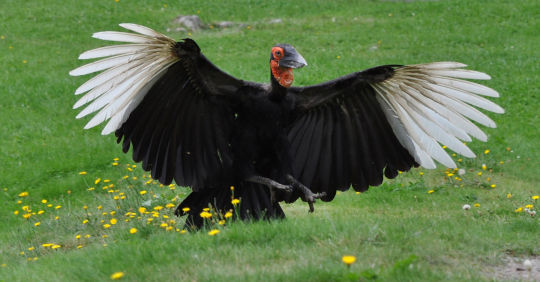
Southern Ground Hornbill by Neil McIntosh, CC BY 2.0
Etymology: Hornbill Crow
First Described By: Lesson, 1830
Classification: Dinosauromorpha, Dinosauriformes, Dracohors, Dinosauria, Saurischia, Eusaurischia, Theropoda, Neotheropoda, Averostra, Tetanurae, Orionides, Avetheropoda, Coelurosauria, Tyrannoraptora, Maniraptoromorpha, Maniraptoriformes, Maniraptora, Pennaraptora, Paraves, Eumaniraptora, Averaptora, Avialae, Euavialae, Avebrevicauda, Pygostaylia, Ornithothoraces, Euornithes, Ornithuromorpha, Ornithurae, Neornithes, Neognathae, Neoaves, Inopinaves, Telluraves, Afroaves, Coraciimorphae, Cavitaves, Eucavitaves, Picocoraciae, Bucerotiformes, Buceroti, Bucorvidae
Referred Species: B. brailloni, B. leadbeateri (Southern Ground Hornbill), B. abyssinicus (Abyssinian/Northern Ground Hornbill)
Status: Extinct - Extant, Vulnerable
Time and Place: From about 12 million years ago, in the Serravallian of the Miocene, through today


Ground Hornbills are known from across the entire African continent

Physical Description: Ground Hornbills are truly impressive living dinosaurs, large in body and bulky in form. They can reach up to 100 centimeters in length, weighing as much as 6 kilograms. They are black over most of their bodies (leading to their being named for crows and ravens, which they are not closely related to at all), with grey legs and grey bills. They also have grey crests on the tops of their heads. Their heads feature bright coloration which is distinguished from the rest of the body - red patches, blue patches, yellow bits, and wattles, which vary from species to species. The undersides of their wings are white, and they have short and thin tails. Called hornbills for their very large, pointed beaks, these bills make up a major chunk of their heads. They also, interestingly enough, have eyelashes on their eyes to aid in protecting them. The juveniles are somewhat brown, and they become more black in color as they age.
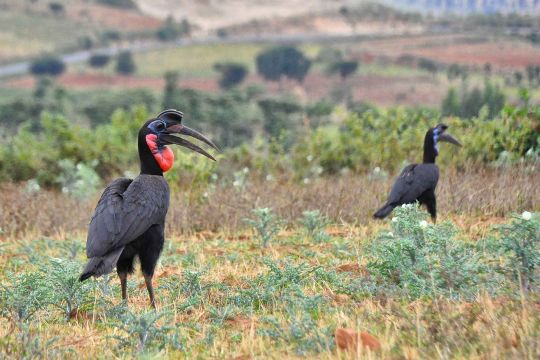
Northern Ground Hornbills by Rod Waddington, CC BY-SA 2.0
Diet: Ground Hornbills primarily feed upon arthropods such as insects, spiders, and scorpions. They also feed upon other invertebrates like snails, and larger prey such as snakes, lizards, small mammals, and carrion. Though they have been recorded feeding upon berries, they are primarily carnivorous.
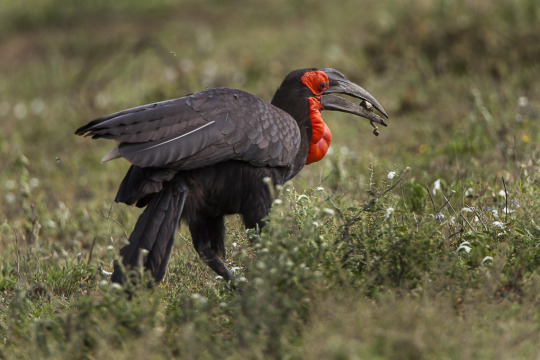
Southern Ground Hornbill by Francesco Veronesi, CC BY-SA 2.0
Behavior: Ground Hornbills are extremely fascinating creatures, able to fly but spending most of their time on the ground searching for sources of food. They will move slowly and carefully, searching around for prey that then is picked up with their large bill, very carefully and in a picky fashion from the ground. They forage in small groups - with a mate, or with their offspring. They rarely gather in large groups, usually only when food is especially abundant. They’ll even dig into the ground or poop looking for food. When large prey is found, groups will gather and attack it together, dismembering it as a team. These are extremely vocal birds, making low-pitched hoots at each other often at two different pitches. They will make softer hoots when snuggling with each other, and deep alarm grunts. They are often known to call for long periods of time. They do not migrate, but do wander about; juveniles will stay where their parents lived for many years.
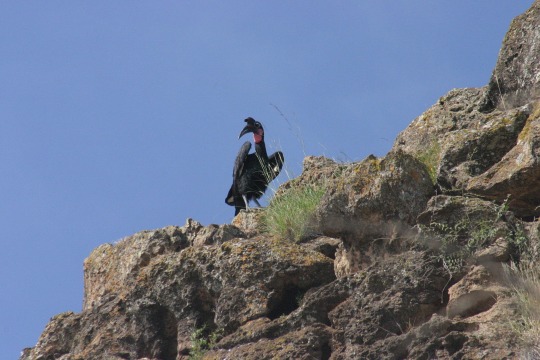
Northern Ground Hornbill by Sakari A. Maaranen, CC BY 3.0
The Ground Hornbills are cooperative breeders - the dominant pair will be assisted by juvenile and younger adult helpers, all defending the nesting territory fiercely. Males will prepare their nests in large tree cavities, sometimes in rock holes or baskets - they will line the hole with dry leaves, and not seal the entrance. Two to three eggs are laid and incubated for two months by the dominant female of the group. Upon hatching, the group members will feed the babies together, but usually the second or third eggs don’t survive - either the eggs don’t hatch, or the chicks starve to death. The chicks stay in the nest for three more months, and the juveniles stick with their families for a little while after hatching. They tend to reach sexual maturity between six and seven, but they don’t usually breed for the first time until later. They also tend to breed only once every three years - a rarity for birds. The birds can live for a very long time - in captivity, they’ve been seen living for up to 40 years.
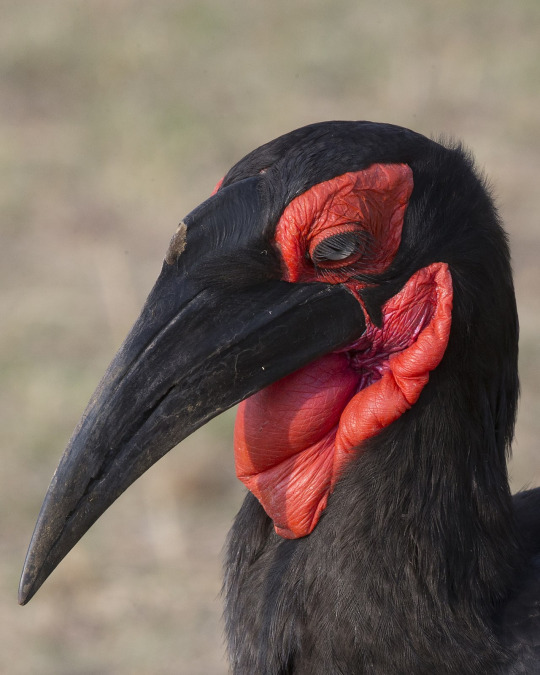
Southern Ground Hornbill by Lip Kee, CC BY-SA 2.0
Ecosystem: Ground Hornbills live in a variety of habitats, across woodland and savanna, as well as grassland patches. The Southern Ground Hornbills live in more moist habitats than the Northern Ground Hornbills. They are often fed upon by large carnivores such as leopards, and can be a host for a wide variety of parasites and diseases.

Northern Ground Hornbill by Bernard Dupont, CC BY-SA 2.0
Other: All living Ground Hornbills are recorded as being vulnerable to extinction at this time. Despite being extremely widespread, they are sparse across their range. This sparseness makes it harder for them to find others of their species and mate with them. They are often hunted and killed, or even murdered as a bringer of bad luck in some cultures. Ground Hornbills also break window panes and are killed for that, in addition to being killed for being a harbinger of drought. Habitat loss also greatly contributes to their decline in population. They do live in several national parks, and there are conservation efforts to aid in its reproduction, using the abandoned eggs to raise more of the birds. Reintroduction, however, is more difficult than anticipated.
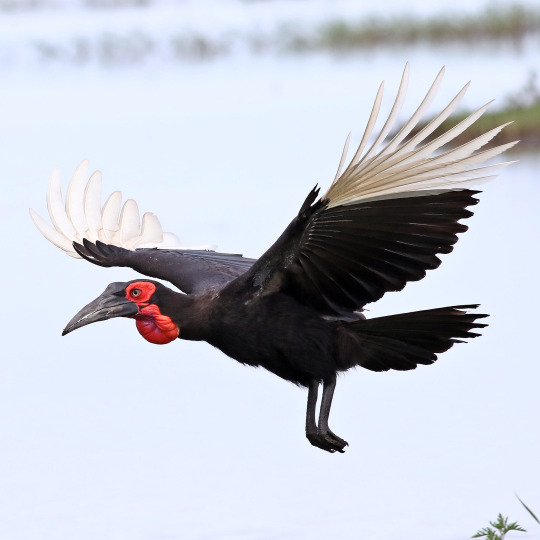
Southern Ground Hornbill by Derek Keats, CC BY 2.0
Species Differences: The Northern Ground-Hornbill is known from Central Africa, and features blue patches on its face with a yellow bit in the front. Males have red additions to their throat wattles. The Southern Ground-Hornbill, on the other hand, is all red, with no yellow or blue to be found. They are also found in southern Africa. In addition to all of this, the Northern Ground-Hornbill is somewhat lighter in weight than the Southern Ground-Hornbill. The extinct species, B. brailloni, was from much more north - in Morocco - and was much older, as well as a little smaller, than its living relatives.

Northern Ground Hornbill by Noel Reynolds, CC BY 2.0
~ By Meig Dickson
Sources under the Cut
Gill, Frank; Donsker, David, eds. (2019). "Mousebirds, Cuckoo Roller, trogons, hoopoes, hornbills". World Bird List Version 9.2. International Ornithologists' Union. Retrieved 23 July 2019.
Gonzalez, J.-C.T.; Sheldon, B.C.; Collar, N.J.; Tobias, J.A. (2013). "A comprehensive molecular phylogeny for the hornbills (Aves: Bucerotidae)". Molecular Phylogenetics and Evolution. 67 (2): 468–483.
Jobling, James A. (2010). The Helm Dictionary of Scientific Bird Names. London: Christopher Helm. p. 80.
Kemp, A. C. 1995. The Hornbills. Oxford University Press, Oxford.
Kemp, A.C. & Boesman, P. (2019). Northern Ground-hornbill (Bucorvus abyssinicus). In: del Hoyo, J., Elliott, A., Sargatal, J., Christie, D.A. & de Juana, E. (eds.). Handbook of the Birds of the World Alive. Lynx Edicions, Barcelona.
Kemp, A.C. & Boesman, P. (2019). Southern Ground-hornbill (Bucorvus leadbeateri). In: del Hoyo, J., Elliott, A., Sargatal, J., Christie, D.A. & de Juana, E. (eds.). Handbook of the Birds of the World Alive. Lynx Edicions, Barcelona.
Kinnaird Margaret F. and O‘Brien, Timothy G.; The Ecology and Conservation of Asian Hornbills: Farmers of the Forest; pp. 20-23.
Lesson, René (1830). Traité d'Ornithologie, ou Tableau Méthodique (in French). Paris: F.G. Levrault. p. 256
Peters, James Lee, ed. (1945). Check-list of Birds of the World. Volume 5. Cambridge, Massachusetts: Harvard University Press. p. 272.
Skutch; Alexander Frank (author) and Gardner, Dana (illustrator) Helpers at birds' nests : a worldwide survey of cooperative breeding and related behavior pp. 69-71. Published 1987 by University of Iowa Press.
Wasser, D. E. and Sherman, P.W.; “Avian longevities and their interpretation under evolutionary theories of senescence” in Journal of Zoology 2 November 2009
#Bucorvus#Ground Hornbill#Bird#Dinosaur#Hornbill#Birblr#Factfile#Bucorvus brailloni#Bucorvus leadbeateri#Bucorvus abyssinicus#Southern Ground Hornbill#Palaeoblr#Abyssinian Ground Hornbill#Northern Ground Hornbill#Afroavian#Terrestrial Tuesday#Carnivore#Africa#Quaternary#Neogene#paleontology#prehistory#prehistoric life#dinosaurs#biology#a dinosaur a day#a-dinosaur-a-day#dinosaur of the day#dinosaur-of-the-day#science
120 notes
·
View notes